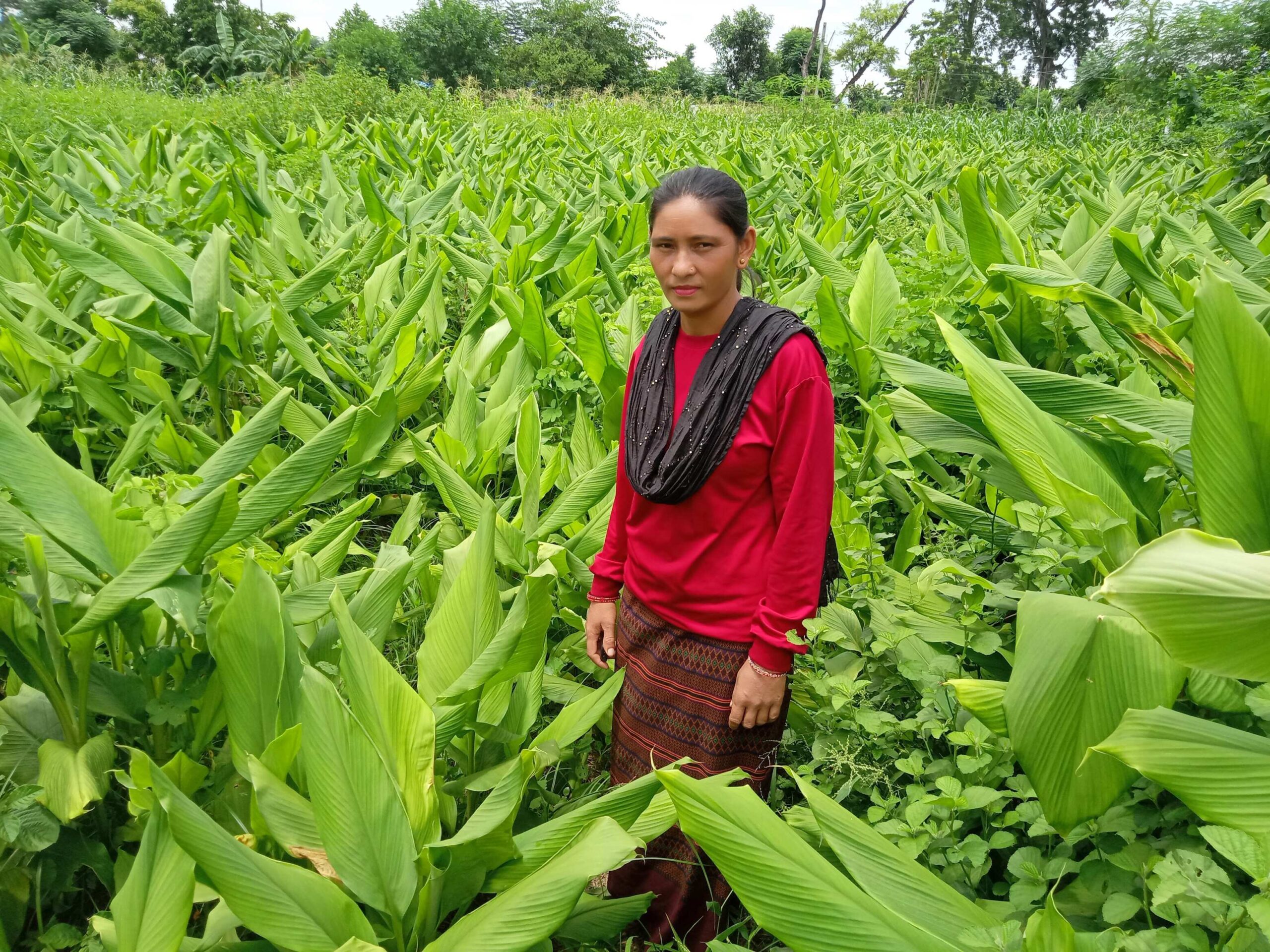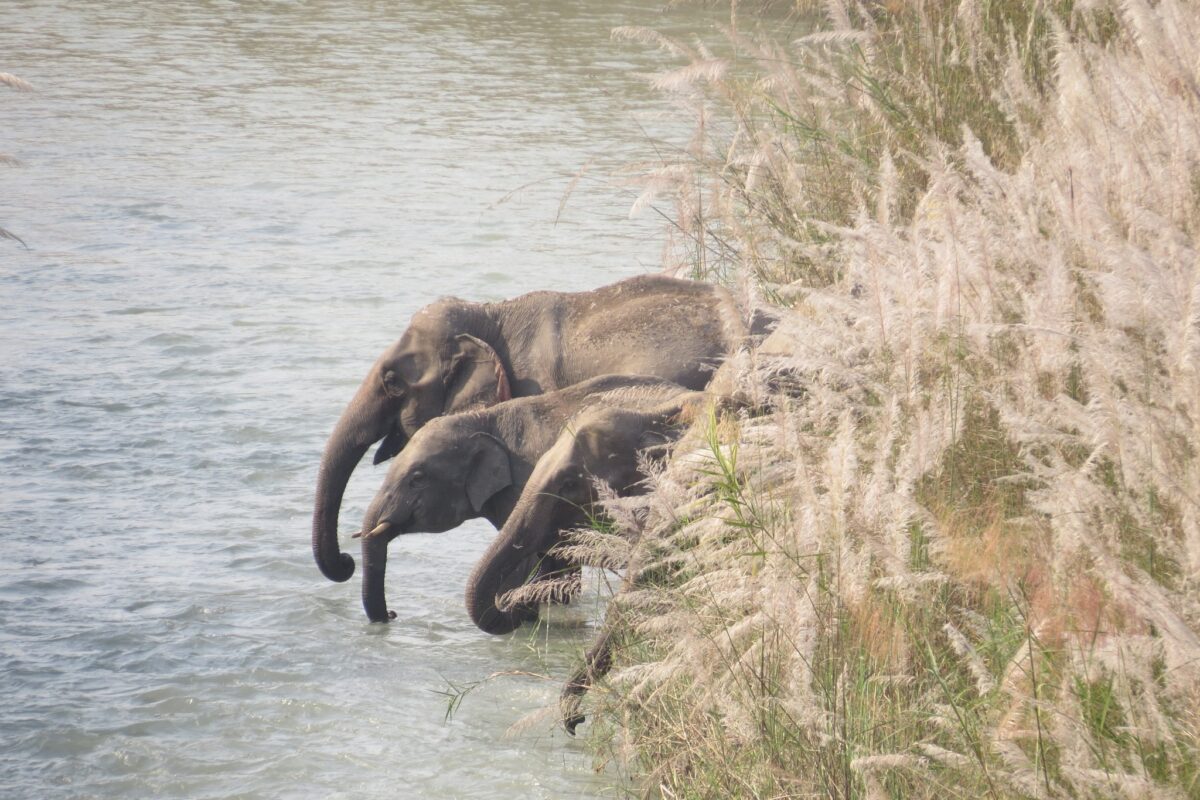- In western Nepal’s Bardiya district, farmers from marginalized communities are replacing traditional crops with turmeric — a plant elephants avoid — dramatically reducing human-elephant conflict.
- Backed by conservation groups and supported by scientific studies, the community-led shift to turmeric farming offers a replicable model for coexistence.
- The initiative combines traditional knowledge, scientific research and targeted support to turn a long-standing conservation challenge into an opportunity for ecological and economic resilience.
KATHMANDU — Nayaram Sunar vividly remembers the day at the end of monsoon season in 2019, when rain was pouring in relentlessly on his sister’s corn field in the village of Madhuwan in western Nepal’s Bardiya district. A wild elephant (Elephas maximus) not only feasted on the harvest but smashed the family’s modest house. His sister and her children fled to a neighbor’s home for safety.
“I felt terrible,” Sunar recalls. “That’s when I thought: Something must be done.”
Sunar, 48, lives in Kailashi, a village nestled between Bardiya National Park and the Kailashi Mid-Hill Community Forest in Nepal’s Lumbini province. Here, human-wildlife conflict is part of everyday life. “We couldn’t even earn 5,000 rupees [$36] from 5 kattha [6,800 square feet] of land,” he says. “The crops didn’t survive. Elephants, wild boars, deer, monkeys — they destroyed everything.”
A 2023 study in Bardiya’s Khata corridor, a critical elephant migration route, found that up to 45% of annual crop yield was lost to raids in some settlements, particularly those near rivers and forests. Households closer to park headquarters or protected by patrols experienced significantly less damage.

A year after the incident, Sunar mobilized his neighbors to form the Sahara Farmers’ Group, now 40 members strong and made up mostly of Dalit and Indigenous families from Madhuwan and Thakurbaba municipalities. With training and turmeric seeds provided by the Dalit Women’s Upliftment Association, a local nonprofit, they began planting crops that might survive the raids.
While farmers in the Indian state of Assam have deterred elephants by planting lemon, Sunar says his community chose turmeric instead, citing lemon’s limited durability and weaker market access compared with the spice, which the elephants don’t like. “Unlike turmeric, lemon can’t be stored for long. We opted for turmeric because it lasts longer and is used in almost every household,” he tells Mongabay.
From conflict to crop shift
Their effort drew the attention of conservation organizations, including the National Trust for Nature Conservation (NTNC), Zoological Society of London, the non-profit Ujyalo Nepal and Bardiya National Park. These groups provided agronomic training and rhizome seeds.
In 2021, NTNC launched “Hatti Beshar” or Elephant Turmeric, a community-based program encouraging farmers to replace high-risk crops with turmeric. The initiative provides rhizomes, training, solar dryers, grinders and packaging materials to the farmers under the Sahara Farmers’ Group, which Sunar leads. With NTNC’s help, the group set up a turmeric processing center and began buying turmeric from neighboring villages.
“We decided collectively to stop growing crops that wild animals would damage,” Sunar says. “Why should we keep planting things that bring us misery?”
Farmers had previously tried lemongrass and chamomile, but these proved unsustainable due to poor market access. Turmeric, by contrast, was resilient, relatively marketable and elephants stayed away. “Ginger and turmeric have proven effective,” says Ashok Kumar Ram, senior conservation officer at Bardiya National Park.
The wild Asian elephants are habitat generalists with enormous appetites, consuming 150-200 kilograms (330-440 pounds) of food daily, according to Ram.

Elephants once ranged freely across Nepal’s southern plains, traversing an east–west corridor spanning more than 900 kilometers (560 miles). The plains of Nepal’s three major rivers — the Koshi, Gandaki and Karnali — offered abundant food, while vast uninhabited lands allowed them to move with little hindrance. But growing human migration, particularly from the hills to southern plains, combined with expansion of roads and human settlements, has fragmented their migratory routes, resulting in the split of elephant populations in the east and west. Today, the endangered elephants in the west are largely confined to Bardiya and Shuklaphanta national parks and their surroundings. Although forests remain their main food source, shrinking habitats and growing settlements increasingly drive them into villages.
“Crops like maize and rice are calorie-rich and easy targets,” says Ajit Tumbahamphe, NTNC’s senior conservation officer in Bardiya. “They’re unguarded and abundant.”
Although a 60-km (37-mi) electric fence lines some parts of the national park’s buffer zone, it frequently fails. “If it’s overgrown with grass or damaged, it short-circuits,” Tumbahamphe says. “Sometimes elephants break it, and repairs take time.”
Older, experienced elephants often teach younger bulls to raid farms, says Ram, an elephant researcher. “It’s learned behavior,” he adds. “They even guide juveniles toward the houses and farms.”
Why turmeric works
A 2017 study near Bardiya National Park confirmed what local farmers had discovered: Elephants avoid turmeric. Although the animals occasionally walked through turmeric fields, they never fed on the crop. Neighboring rice plots, however, were repeatedly raided. Scientists say they believe turmeric’s strong odor and bitter compounds make it unpalatable. Importantly, turmeric also yielded more profit per hectare than rice during the two-year study. According to the study, turmeric generated revenue of 178,168 rupees ($1,270) per hectare (2.5 acres) during the period, compared with 72,945 rupees ($520) per hectare for rice.

Meanwhile, a 2021 study spotlighted how elephant damage worsens social inequality. Based on interviews with 240 farmers and 31 settlement leaders, it found that poorer households closest to the park, typically with smaller landholdings, faced the worst losses, often up to 17% of their annual rice harvest. These farmers were also least able to afford insurance schemes. The study concluded that conservation, if not equitably managed, risks becoming an economic burden for the most vulnerable.
The impact has been transformative. On the same plot, Sunar alone now earns 70,000 rupees ($500) annually from turmeric sales — nearly 10 times what he earned from maize. The group has sold 66 quintals (7.3 tons) of turmeric powder in the last two years, earning 1.6 million rupees ($11,405). They now supply turmeric powder to major cities including Kathmandu, Pokhara, Nepalgunj and Dhangadhi.
“It’s not just about the money,” Sunar says. “It’s about peace of mind. We’ve found a way to live alongside elephants instead of fearing them.”
For Sabitri Sunar, the group’s 37-year-old secretary and a single mother, the change has brought both safety and self-reliance. Fifteen years ago, she lost her corn to a raiding elephant. Today, turmeric cultivation supports her children’s education. She earned 12,500 rupees ($89) in 2024, which helped her pay their school fees.
“If we had kept planting rice and maize, the wild animals would’ve taken it all,” she says. “Since switching to turmeric and vegetables, the elephants haven’t returned.”
As Nepal’s traditional forest corridors shrink, crop raids and human fatalities are expected to rise. The turmeric farming in Bardiya, blending community knowledge and conservation partnerships, provides a model for coexistence.
“These elephants are our national treasures,” Sunar says, surveying his fields. “If we protect them, we survive too. If we don’t, neither will we.”
Reporting contributed by Prem Bishowkarma in Bardiya.
Cover image: Wild elephants drinking from a stream near Bardiya National Park in Nepal. Image courtesy of Bardiya National Park.
How a Nepali border village learned to live with migratory wild elephants
As elephant conflict shifts, Nepal’s border village offers clues for coexistence
Citations:
Sagar, P., Umesh, P., & Rabin Bahadur, K. (2023). Crop raiding pattern by elephant in Nepal: A case study of Khata corridor. International Journal of Plant, Animal and Environmental Sciences, 13(04). doi:10.26502/ijpaes.4490158
Prins, H. H., Liefting, Y., & De Jong, J. F. (2021). Marginal farmers carry the burden of damage caused by Asian elephantsElephas maximusin Bardiya National Park, Nepal. Oryx, 56(1), 73-81. doi:10.1017/s0030605319001431
Gross, E. M., Drouet-Hoguet, N., Subedi, N., & Gross, J. (2017). The potential of medicinal and aromatic plants (MAPs) to reduce crop damages by Asian elephants ( Elephas Maximus ). Crop Protection, 100, 29-37. doi:10.1016/j.cropro.2017.06.002
FEEDBACK: Use this form to send a message to the author of this post. If you want to post a public comment, you can do that at the bottom of the page.
Source link
#western #Nepal #farmers #switch #growing #turmeric #elephants #stay
